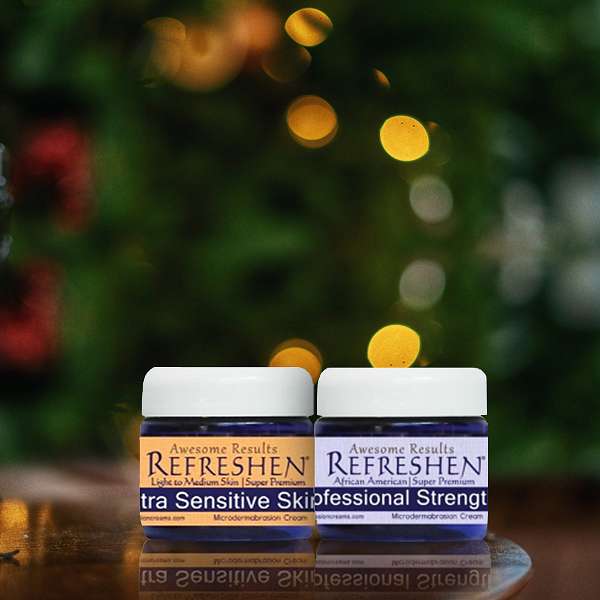
WELCOME TO - REFRESHEN MICRODERMABRASIONCREAMS.COM
Discover the secret to turning back the clock with REFRESHEN, the ultimate skincare solution for anyone 40 and older. In just one minute a day, at only 50 cents per use, you can rejuvenate your skin and achieve a youthful glow. REFRESHEN works to reverse the physiological signs of aging, giving you a fresher, younger appearance.
Learn about the incredible benefits of exfoliating with REFRESHEN. The Plum label jars, specially formulated for African American, Dark or Dry skin, and the Orange Label jars for Light or Oily skin. Our products are GMO-free, never tested on animals, and free from fragrances, ensuring they're gentle on your skin and the environment. Plus, with free shipping, you can skip the mall and have your skincare delivered straight to your door. Try REFRESHEN today and experience the youthful transformation.
WELCOME TO - REFRESHEN MICRODERMABRASIONCREAMS.COM
BASIC SKIN TYPES AND TIPS
Basic Skin Types and Tips: Understanding and Caring for Your Unique Skin
In this podcast, we explore the five basic skin types—normal, oily, dry, combination, and sensitive—and share tips to help you maintain healthy, radiant skin. By understanding your skin type and following a tailored skincare routine, you can address common concerns and unlock your skin’s full potential.
Determining Your Skin Type
To identify your skin type:
- Wash your face with a gentle cleanser and pat it dry.
- Wait 1-2 hours for your skin to return to its natural state.
- Perform the tissue paper test by dabbing soft tissue across your face, especially the T-zone.
Results:
- Normal Skin: Soft, smooth, no oil or flakiness.
- Oily Skin: Greasy marks on tissue, shiny T-zone.
- Dry Skin: Peeling, flakiness, or tightness.
- Combination Skin: Oily T-zone, dry or normal cheeks.
- Sensitive Skin: Thin, delicate, easily irritated or red.
Skin Types and Care Tips
1. Normal Skin
The least problematic type, normal skin is healthy, radiant, and breakout-free. Pores are small, and texture is even.
Tips for Normal Skin
- Cleanse with warm water and a super-premium face wash twice daily.
- Use oil-free moisturizers and allow them to absorb for 10 minutes before applying makeup.
- Remove makeup as soon as you’re home, not just before bed.
- Wear sunscreen when outdoors for more than an hour.
2. Oily Skin
Characterized by excessive oil, this skin type often has large pores, a coarser texture, and a shiny T-zone. It’s prone to acne, especially in humid weather or stressful conditions.
Tips for Oily Skin
- Use oil-free, non-comedogenic face products.
- Cleanse with warm water and a super-premium face wash.
- Apply acne treatments with benzoyl peroxide twice daily.
- Use blotting paper during the day to manage shine.
- Avoid over-washing or over-exfoliating, as this can exacerbate oil production.
3. Dry Skin
Dry skin feels tight, flaky, and prone to early aging, fine lines, and redness. Pores are small, and the texture is thin or papery.
Tips for Dry Skin
- Use rich, creamy cleansers with ingredients like glycerin and Shea butter.
- Rinse with cool water after cleansing.
- Apply night creams for long-lasting hydration during the day.
- Avoid alcohol-based or gel products.
4. Combination Skin
The most common type, combination skin has an oily T-zone (forehead, nose, chin) and normal-to-dry cheeks.
Tips for Combination Skin
- Use different cleansers for oily and dry areas.
- Apply astringent to the T-zone and a freshener for dry areas.
- Moisturize dry areas with rich creams while using lighter products for oily areas.
- Opt for matte mineral makeup and foundations.
5. Sensitive Skin
Delicate and easily irritated, sensitive skin reacts to medications, allergens, and certain products. It’s prone to redness, itching, inflammation, and dryness.
Tips for Sensitive Skin
- Use fragrance-free, hypoallergenic skincare products.
- Spot-test new products behind your ear for three nights before applying them to your face.
- Stick to mineral-based makeup.
- Consult a dermatologist for personalized care.
Why Microdermabrasion Benefits All Skin Types
Microdermabrasion, performed once daily, is a highly effective skincare treatment for age spots, discoloration, wrinkles, and even acne. It gently exfoliates dead skin cells, unclogs pores, and promotes skin renewal, delivering a b